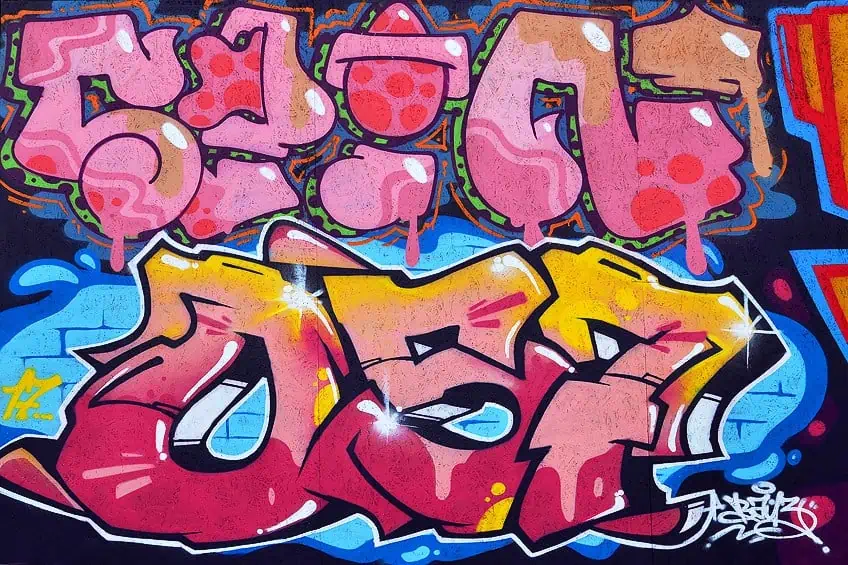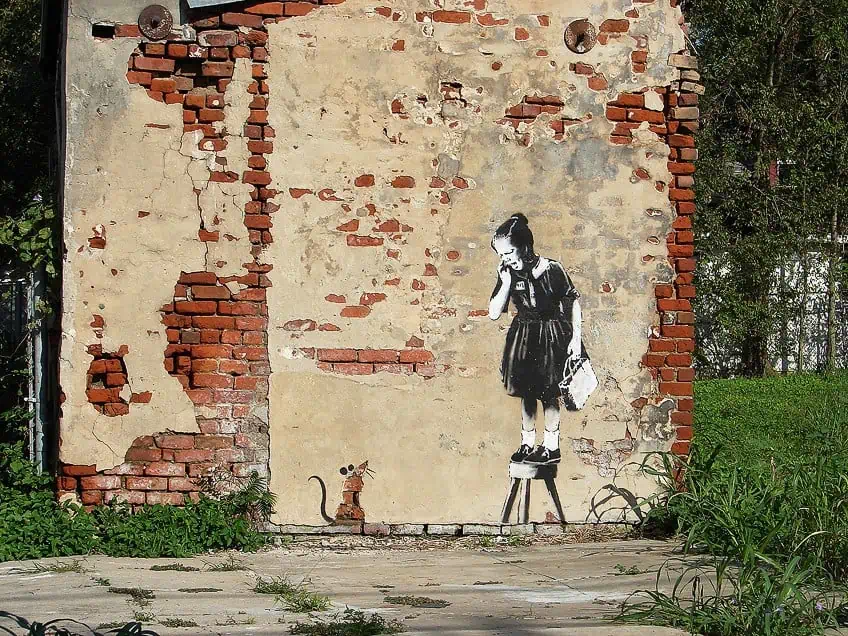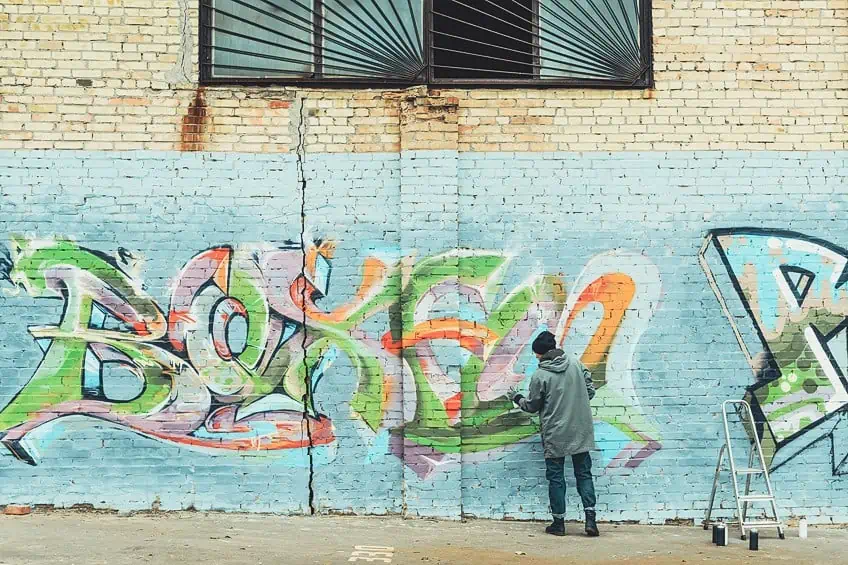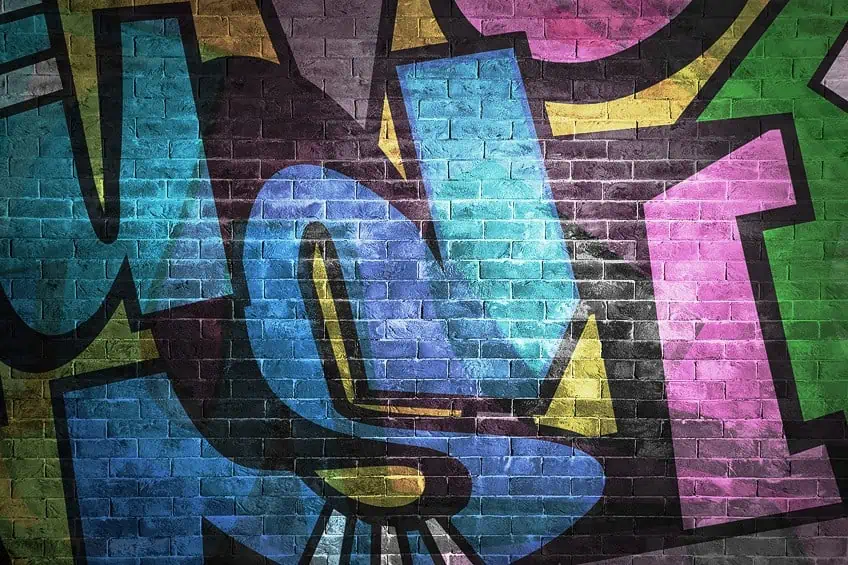Graffiti Tags – Examples of Tagging Graffiti
This post may contain affiliate links. We may earn a small commission from purchases made through them, at no additional cost to you.
Graffiti tags have become a common sight in city environments around the world, and as such, they are possibly one of the most commonly seen examples of art that people get to see in their day-to-day lives. This is why graffiti tags are worth examining. We will be looking at this famous form of street art today, and we will be discussing the history of graffiti, some common tagging designs, a few famous taggers, and the ultimate legality of tagging and graffiti in general. There is much to learn, so let’s get started!
Table of Contents
A Look at Graffiti Tags
While we tend to think of graffiti as emblematic of the modern urban era, this is not actually accurate. Graffiti has existed for about as long as human beings have been building structures onto which people can graffiti. There are even instances of graffiti on ancient Egyptian sites from the period in which they were constructed. However, modern-day graffiti is something altogether different.
Graffiti has become a culture all on its own, and graffiti tags are perhaps the most dominant form of that particular culture.
There are numerous tagging designs that have been created over the last few decades, and they have become a staple of urban environments. You may not personally appreciate them (or you may love them), but they are here to stay. But what is a graffiti tag in the first place? These basic forms of modern-day graffiti are simple and generally single-color signatures that can be easily applied to a surface. In addition, sometimes there are other forms of tagging, such as graffiti handstyles, which are more sophisticated tags, or the use of ready-made stickers that can be applied even more quickly. The speed at which tags are generally applied is because graffiti is still generally illegal in most cities.

The purpose of tagging graffiti is that it serves as a signature of sorts. It is meant to be a signal to fellow street artists. They can also be used to mark certain locations as the territory of the one doing the tagging, and for this reason, there is sometimes an association between certain types of graffiti tagging and gang activity.
However, this is not necessarily the case (although it can be at times).
A Brief History of Graffiti Tags
Graffiti, as has been mentioned, may have been around for a very long time and can even be found in antiquity, but the modern graffiti movement is considerably younger. While graffiti may have been used a little earlier as gang symbols, the modern graffiti tagging movement is considered to have started in 1967 because of a high school student.
This high school student went by the moniker Cornbread, and he started tagging the American city of Philadelphia in an attempt to both gain the attention of a girl and to establish his own notoriety around the city.
His attempts quickly caught the attention of others, and the modern graffiti scene essentially started in New York City. The earliest targets of graffiti tags were the subway trains that could be found throughout the city, and a thriving scene built up around hip-hop culture. Tags quickly became one of the most common forms as they could be easily applied and were personalized to each individual artist. However, street art of any description took quite some time before it started to be recognized as an artform in its own right.

Galleries and museums would only first start exhibiting street art designs in the 1980s. Regardless of street art becoming a more accepted form of artistry in the present day, it is still often associated with vandalism and even gang-related activity.
It continues to develop to this day despite the gray legality of graffiti in general, and so graffiti tags are here to stay.
Common Tagging Designs
Graffiti tags are usually created using either spray paint or markers, and as they are meant to be signatures of sorts, they are not usually all that large or complex. However, the complexity of graffiti tags does form part of the idiosyncratic style of each individual street artist. There are several different types of tagging designs, and they are worth examining:
- Handstyle graffiti: This particular type of graffiti is considered to be one of the standard forms as it is the name given to the particular style of an individual artist. This means that handstyle graffiti can vary based on who creates it. It can be immensely complex or relatively simple, legible or illegible, colorful or monotone, and so on. It depends on what the street artist wants to do with their particular graffiti tags.
- One-liner graffiti: This is another simple form of graffiti tags. The idea is that it is a quick and easy way to tag names. Graffiti of this kind is so named because it involves the entire tag being created with one line. This means that a one-liner does not involve the lifting of the spray paint can or marker. It is a speedy means of leaving a tag, but they can still vary in complexity based on the abilities of the street artist in question.
- Throw-up graffiti: This type of tag is a slightly more sophisticated type of tagging design. It entails the use of two or more colors, an outline, and a fill-in. They can still be completed relatively quickly, but they generally take longer to create than handstyle graffiti or one-liners.

These are some of the primary graffiti tag types that exist, but even though there are few that have been discussed here, the point of a tag is that it is individualized to each street artist. This means that every single artist’s tag is meant to be different from every other artist’s tag, and the amount of creativity that therefore goes into many of these tagging designs can be truly astronomical.
Famous Graffiti Taggers
There have been many famous graffiti taggers in our world over the years, and we will have a look at a few of them today. Some of them are innovators and others have simply made an impressive name for themselves because of their work. Let’s give them some attention:
- Cornbread (1953 – Present): This American street artist is considered by many to be the originator of tagging. He started tagging in the 1960s and 1970s in Philadelphia in an attempt to both gain the attention of a girl and to make his graffiti moniker known throughout the city. His work would go on to inspire the modern graffiti art scene when tagging later spread to New York City.
- BLADE (1957 – Present): This American street artist has been called the “King of Graffiti” because of his pioneering work in creating wildstyle graffiti. His work is considered to be intricate. In addition to his innovative work, he painted over 5,000 subway trains over a twelve-year period and gained his moniker because of that feat.
- Lee Quiñones (1960 – Present): This Puerto Rican street artist is considered to be one of the most innovative graffiti artists in the New York City subway graffiti culture. He often made use of political messaging in his work, and he would create massive and elaborate graffiti murals.
- Lady Pink (1964 – Present): This Ecuadorian-American street artist became one of the earliest and most prominent female graffiti artists when she started tagging when she was in her teens. Her work would go on to make extensive use of pink and strong female characters. She was also one of the first graffiti artists to exhibit her work in galleries and museums.
- Banksy (Unknown): This British street artist has been active since the 1990s and is known for his provocative street art style that makes heavy use of social commentary, pop cultural references, and satire. His identity is still unknown to this day, and he has arguably become the most famous graffiti artist in the public consciousness.
 Graffiti mural of a young girl and a rat by Banksy on a 19th-century building in Treme, New Orleans; Mark Gstohl, CC BY 2.0, via Wikimedia Commons
Graffiti mural of a young girl and a rat by Banksy on a 19th-century building in Treme, New Orleans; Mark Gstohl, CC BY 2.0, via Wikimedia Commons
This has been a short list of some of the most famous and prominent graffiti artists to have lived. Each of these artists has pushed the medium to new heights and has attained fame because of it. However, there are many other street artists out there, and they do not all operate within the realm of what could necessarily be called “the law”.
The Legality of Graffiti Tags
The legality of graffiti in general is usually gray at best and illegal at the worst. In most locations, one technically needs the permission of the owner of the property on which the surface being used for graffiti can be found. This is usually not attained, and so most graffiti, including graffiti tags, is illegal. There are occasionally public programs that allow for graffiti to be applied to certain surfaces, but this is not generally the case.
For this reason, most graffiti is considered to be vandalism according to the law.
The punishment associated with vandalism of this nature does vary based on the amount of damage and the associated cost with repairing it, what the graffiti’s content was about, the criminal history of the offender, and the specific laws of the location in which the graffiti tags or other artworks have been applied. Most of the time, graffiti is considered to be a misdemeanor and so may result in fines or community service, but there have been instances of felony charges being used against graffiti artists in the past.

Whether something is a misdemeanor or a felony can vary widely from one place to the next. However, there have been cases in which more sophisticated street art is deemed to be more allowable over the standard tag names. Graffiti of this variety is often seen as little more than vandalism.
And that is our look at graffiti tags! There are many different types of tagging designs, such as graffiti handstyles, and they are generally directly connected to individual street artists. Today, we have looked at the history of graffiti tagging, some common designs, a few individuals who have made a name for themselves because of their graffiti tags, and the ultimate legality of graffiti and tagging in general. Hopefully, this has opened your eyes a little about tagging graffiti and the culture associated with it.
Frequently Asked Questions
What Are Graffiti Tags?
Graffiti tags are some of the most common forms of modern-day graffiti. These graffiti pieces are generally a signature of some sort that is associated with a particular street artist. The idea behind tagging graffiti is that it serves as a means of claiming territory or establishing renown based on the style of the tag itself. This is used to communicate with other street artists and to signal one’s abilities.
What Are Some Common Tagging Designs?
Some of the most common forms of tagging designs include graffiti handstyles, which are the personalized way in which a particular artist creates their tag. These particular types vary significantly and can range from simple to complex. In addition, there are tagging designs like one-liners, which are applied without lifting the spray can or marker, or throw-ups, which make use of multiple colors and contain outlines and fill-ins. However, the variability of graffiti tags is practically infinite as every artist will have their own style.
Are Tags the Most Common Form of Graffiti?
Tags form a larger group of graffiti types under which other sub-categories can exist, but because of the usual ease and speed at which they can be applied, they are often the most numerous types that one can find. Tags are also often considered to be the foundation of graffiti culture in general, and as such, practically every street artist will have their own tag design. So, it may be safe to assume that graffiti tags are the most common type of graffiti.
Is Graffiti Tagging Illegal?
Graffiti of any description is illegal in most locations across the globe. There are instances in which a street artist will be given permission to use a surface, but as most graffiti is performed in a location without the permission of the owner, graffiti usually falls under the purview of illegal vandalism. This means that graffiti can be punished through misdemeanor or felony charges, but the former is more common than the latter.
Who Is the Most Famous Graffiti Tagger?
It is possible that the most famous graffiti artist in general, and also the most famous tagger, would be Banksy. This pseudonymous British figure has become incredibly famous outside of graffiti circles, and his mainstream appeal and social commentary-oriented artworks have made him an immensely well-known figure.
In 2005, Charlene completed her wellness degrees in therapeutic aromatherapy and reflexology at the International School of Reflexology and Meridian Therapy. She worked for a company offering corporate wellness programs for several years before opening her own therapy practice. In 2015, she was asked by a digital marketer friend to join her company as a content creator, and it was here that she discovered her enthusiasm for writing. Since entering the world of content creation, she has gained a lot of experience over the years writing about various topics such as beauty, health, wellness, travel, crafting, and much more. Due to various circumstances, she had to give up her therapy practice and now works as a freelance writer. Since she is a very creative person and as a balance to writing likes to be active in various areas of art and crafts, the activity at acrylgiessen.com is perfect for her to contribute their knowledge and experience in various creative topics.
Learn more about Charlene Lewis and about us.







